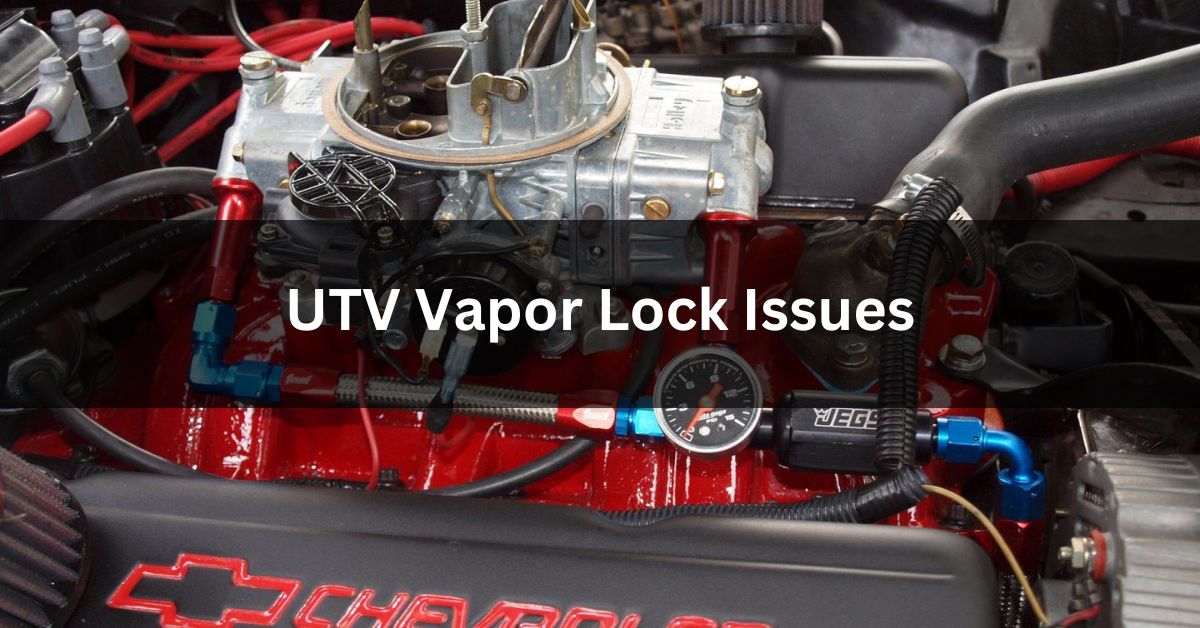Vapor Lock is a great feature a vehicle will have, but sometimes it just starts to come up with so many problems. Like in UTV, The vapor lock stops working and does not proceed the way it supposes to.
Basically, This Happen because of the high ambient temperature of the surrounding, Inadequate Fuel Line Insulation, Engine Compartment Heat, or inefficient fueling system having Ethanol Blended liquids.
But Don’t get worried, by working on all these factors you can easily avoid them and can have a smooth running system. So, Let’s get started!
What is Vapor Lock? – For Those Who Don’t Know!
Before we dive deep into the system, I would like you to know about the Basics of this issue. Generally, Vapor lock is a phenomenon that occurs in the fuel system of a vehicle, where liquid fuel changes state from liquid to vapor before it reaches the combustion chamber.
This premature vaporization prevents the fuel from flowing properly, leading to engine malfunction or even complete stalling. It’s more common in high-temperature environments, making it a critical concern for UTV enthusiasts.
Reasons Why UTVs Have Vapor Lock Problems – Basic Causes You Must Know!
Vapor lock can be a frustrating issue for UTV owners, causing engine performance problems and potential breakdowns.
Several factors can contribute to the occurrence of vapor lock in a UTV.
Let’s explore the main reasons why UTVs can experience vapor lock and the associated challenges they present.
High Ambient Temperatures:
One of the most common reasons for the problem with this amazing feature is the High ambient temperatures which play a significant role.
When the temperature rises, the heat can transfer to the fuel lines and cause the fuel to vaporize prematurely.
This vaporization can create air pockets or bubbles in the fuel system, disrupting the proper flow of fuel to the engine.
As a result, the engine may experience fuel starvation, leading to stalling, rough idling, or even complete engine failure.
Inadequate Fuel Line Insulation Can Also Be A Cause:
Another common cause of UTV vapor lock is inadequate insulation of the fuel lines. UTVs that do not have proper insulation around their fuel lines are more susceptible to heat transfer from the surrounding environment.
Without insulation, the fuel lines can absorb excess heat, increasing the likelihood of fuel vaporization and subsequent vapor lock issues.
Insufficient insulation can be particularly problematic when riding in hot climates or engaging in prolonged off-road adventures.
Engine Compartment Heat:
The heat generated by the UTV’s engine can contribute to vapor lock problems as well.
If the engine compartment lacks sufficient ventilation or insulation, the high temperatures generated during operation can impact the fuel lines, fuel pump, and other components.
The intense heat can cause the fuel to reach its boiling point prematurely, leading to vaporization and fuel flow disruptions.
Proper ventilation, insulation, and heat management within the engine compartment is crucial for minimizing the risk of vapor lock.
Ethanol Blended Fuels Is Another Reason:
The increasing use of ethanol-blended fuels can also contribute to UTV vapor lock issues. Ethanol has a lower boiling point compared to pure gasoline, making it more prone to vaporization.
When UTVs are fueled with ethanol blends, the risk of vapor lock can be heightened, particularly in high-temperature environments or when the UTV is not in use for extended periods.
Ethanol’s characteristics can exacerbate the vapor lock problem, necessitating additional precautions and fuel management strategies.
How to Fix UTV Vapor Lock Issues? – Detailed Solution Guide!
Insulate Your Fuel Lines: You can resolve this problem by Adding insulation around your fuel lines to protect them from engine heat. This can prevent the fuel from vaporizing prematurely.
Upgrade Your Fuel Pump: Next, Consider upgrading your fuel pump to a model that can handle higher pressure, which can help combat vapor lock issues.
Use a Fuel Additive: Certain fuel additives can raise the boiling point of your fuel, helping to prevent vapor lock. Remember to consult a UTV professional before using these additives.
Consider a Carburetor Design Change: Lastly, If your UTV model is susceptible to vapor lock, a carburetor design change may be necessary. This should be performed by a professional to ensure safety and efficiency.
Frequently Asked Questions:
What are the signs of a vapor lock issue in a UTV?
Signs can include stalling, difficulty starting, or loss of power in high-heat environments. Furthermore, The most common indications include engine stalling or frequent stalling, difficulty starting the engine, or a sudden loss of power during operation, especially in high-heat environments.
These symptoms often occur when the fuel lines become vapor-locked, disrupting the fuel flow and affecting the engine’s performance.
Can Vapor Lock Damage My UTV Engine?
Yes! While vapor locks itself isn’t typically harmful, they can prevent your engine from receiving the fuel it needs, which may lead to engine damage over time. That’s why you have to fix the problem before it gets worst.
How Often Do UTVs Have Vapor Lock Issues?
The frequency of vapor lock issues can vary depending on several factors, including the type of fuel you use, the design of your UTV, and the environmental conditions you operate it. That’s why you must have to take care of all these factors for the next-level working of your UTV.
Heading Towards The End:
In the end, Hope so you know that the UTV gets a problem with its amazing feature named Vapor Lock due to extreme temperature, faulty fuel line insulation, Heat in the Engine Compartment, or due to inappropriate fueling system.
And by working on the factors, you can definitely resolve this problem. So, feel free to implement these details and enjoy fast running UTV.
